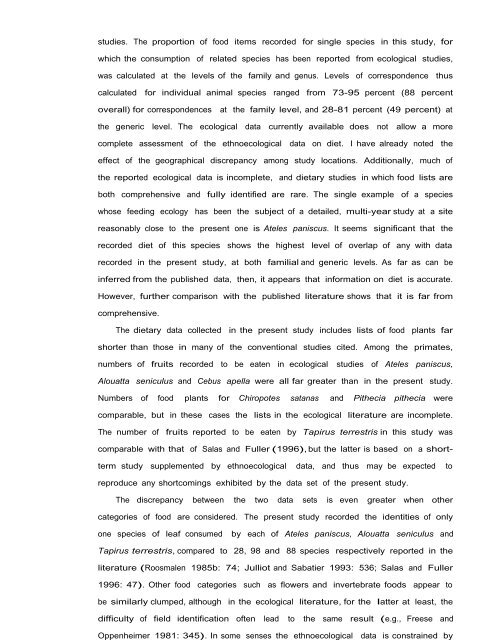Ethnoecology, Resource Use, Conservation And Development In A ...
Ethnoecology, Resource Use, Conservation And Development In A ...
Ethnoecology, Resource Use, Conservation And Development In A ...
Create successful ePaper yourself
Turn your PDF publications into a flip-book with our unique Google optimized e-Paper software.
studies. The proportion of food items recorded for single species in this study, for<br />
which the consumption of related species has been reported from ecological studies,<br />
was calculated at the levels of the family and genus. Levels of correspondence thus<br />
calculated for individual animal species ranged from 73-95 percent (88 percent<br />
overall) for correspondences at the family level, and 28-81 percent (49 percent) at<br />
the generic level. The ecological data currently available does not allow a more<br />
complete assessment of the ethnoecological data on diet. I have already noted the<br />
effect of the geographical discrepancy among study locations. Additionally, much of<br />
the reported ecological data is incomplete, and dietary studies in which food lists are<br />
both comprehensive and fully identified are rare. The single example of a species<br />
whose feeding ecology has been the subject of a detailed, multi-year study at a site<br />
reasonably close to the present one is Ateles paniscus. It seems significant that the<br />
recorded diet of this species shows the highest level of overlap of any with data<br />
recorded in the present study, at both familial and generic levels. As far as can be<br />
inferred from the published data, then, it appears that information on diet is accurate.<br />
However, further comparison with the published literature shows that it is far from<br />
comprehensive.<br />
The dietary data collected in the present study includes lists of food plants far<br />
shorter than those in many of the conventional studies cited. Among the primates,<br />
numbers of fruits recorded to be eaten in ecological studies of Ateles paniscus,<br />
Alouatta seniculus and Cebus apella were all far greater than in the present study.<br />
Numbers of food plants for Chiropotes satanas and Pithecia pithecia were<br />
comparable, but in these cases the lists in the ecological literature are incomplete.<br />
The number of fruits reported to be eaten by Tapirus terrestris in this study was<br />
comparable with that of Salas and Fuller (1996), but the latter is based on a short-<br />
term study supplemented by ethnoecological data, and thus may be expected to<br />
reproduce any shortcomings exhibited by the data set of the present study.<br />
The discrepancy between the two data sets is even greater when other<br />
categories of food are considered. The present study recorded the identities of only<br />
one species of leaf consumed by each of Ateles paniscus, Alouatta seniculus and<br />
Tapirus terrestris, compared to 28, 98 and 88 species respectively reported in the<br />
literature (Roosmalen 1985b: 74; Julliot and Sabatier 1993: 536; Salas and Fuller<br />
1996: 47). Other food categories such as flowers and invertebrate foods appear to<br />
be similarly clumped, although in the ecological literature, for the latter at least, the<br />
difficulty of field identification often lead to the same result (e.g., Freese and<br />
Oppenheimer 1981: 345). <strong>In</strong> some senses the ethnoecological data is constrained by


